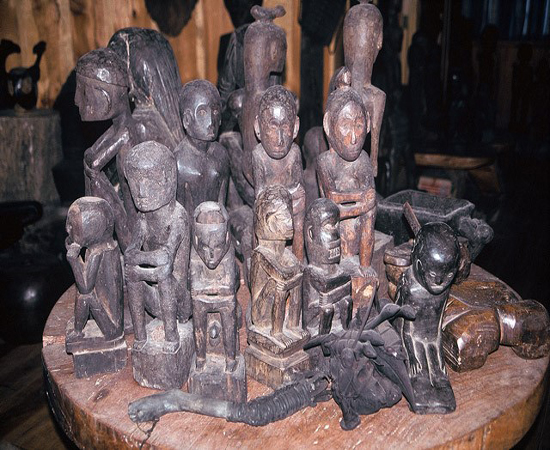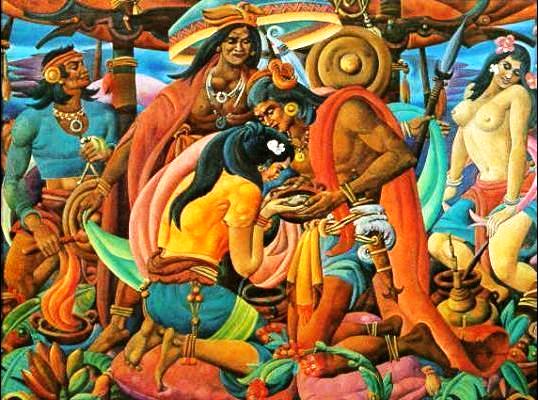The age of animism in our archipelago is an interesting subject that provides us clues as to how Filipinos managed to build their spirituality and the countless rituals they observed. From the most mundane to the most unusual, these rituals were not just a mindless series of intricate offerings and chanting. Like every religion, be it primitive or modern, rituals were often just as important as daily tasks performed to survive in their world. Because of rituals, the most common and important events were elevated and required a spark of the divine.
The following are some of the rituals and practices performed by early Filipinos which shows us how simple activities like farming and fishing were intertwined with the oldest beliefs of our ancestor and and continue to flow from the consciousness of one generation to the next.

Calling The Aid of the Land
Pre-colonial life lacked the complexities of the modern era where needs and vices overlap with one another. The survival of the whole community, or barangay, was the primary concern of everyone – so they worked on their land in order to produce crops, fruits and grain to cover a large portion of their basic necessity. Agriculture became an important part of most ethnic communities in the early Philippines.
Before tilling and cultivating land for their crops, Cebuanos were known to perform the ritual of Tamblan. Consisting of meat from a white chicken or white pork along with wine or Buyo, these offerings would be set on a table in the open field as gifts for the unseen owner or spirit of the land.

Certain taboos were also avoided depending on the crop that would be planted. For rice, one must kill an insect called taga-taga which was believed to possess the soul of the palay. When planting corn, the first three rows should be done at sundown. An individual with broken teeth can not go and plant corn for it was believed to bear low quality grains.
Coconut seedlings were placed on the open ground during a full moon and planted at noontime when sun is directly overhead.
Ube, a root crop that some ethnic groups considered to be sacred, must be kissed when dropped to avoid angering a spirit called Gaba.
The Isneg tribe were watchful for a small whirlwind called alipugpug which was an indication that their harvest would be good. They also tied an uprooted species of fern called takkag to the stalk of their palay which acted as an amulet for their crops.
The Kankanaey group of western Mountain Province also practiced a ritual sacrifice called Legleg to appease spirits that may otherwise hinder the growth of their plants. A chicken would be killed as an offering to all surrounding spirits that might cause the deterioration or stunted growth of their plants – especially their Bonabon seedling. Four or five long feathers of the sacrificial chicken would be planted in the site where the Bonabon seed is located. The ritual was repeated if the growth still remained poor.
Tagalogs called upon their gods such Lakan-bakod ,who they worship for an abundant harvest of their fruit bearing plants and trees. Their rituals were often celebratory in nature where they held a feast in the fields under a canopy. They would build an altar and wooden statue of Lakan-Bakod wherein its genital was gilded and sized to represent the desired rice stalk height. They would give these statues food offerings and wine for assurance of a bountiful harvest season.

Gaining the Favor of the Wind
Their is a strong connection between the weather and crops. Good and fair weather generally leads to a bountiful harvest. However, weather is sometimes a fickle element that can pose problems if it causes phenomenon like drought or typhoons. Most of us have heard of cultural ‘rainmaking’ rituals (rain dance) to call forth rain to the land, but the ethnic group of Subanon, from the mountainous areas of Zamboanga del Sur and Misamis Occidental, Mindanao, performed rituals that were meant to stop heavy downpours or storms, halt drought that destroy their plants, and call upon more favorable winds.
The Magbinukid is a ritual performed in a river by the Baylan (shaman), where they set a stalk of bamboo and place at the top a saucer where an egg sprinkled with apog (powdered limestone), rice, and a portion of chicken meat. Those who attended the ritual would also bring egg, rice and chicken while the Baylan danced to the sounds of a gong.
Kanobiton is another ceremony which is meant for ceasing a dry spell or drought. This can be done anywhere in the community but must be attended by everyone. The Baylan offers a pig or chicken to the spirits of nature to help them ease the drought.
A more elaborate ritual called Lapiraw is done using a windmill made of Bamboo to call on the winds. Once more, animal sacrifice is a major part of the ritual wherein a pig or chicken is offered. Some would also catch a Kasili (swamp or rice eel) which was connected to the belief that there is a huge eel living underneath the earth that causes landslides when it tries to come out of the ground to swim in the sea.
Even without these rituals, the old men of the village could forecast if the condition of the weather was favorable for their planting season. One of the common indicators of an incoming typhoon is when animals behave in an unnatural manner – such as the snails suddenly hiding under banana leaves to take shelter, the whirring sound of winged termites, or agitated ducks and geese.
In Cebu, there is a bird called Kumpisaw whose feathers can be used predict the upcoming weather. When it flies with its tail feather spread out, a storm will definitely come, while the opposite is also true. For Bicolanos, the leaves of the plant known by the name of Solay-Bagyo acts like a weather monitor. If its leaves are drawn into the stem, it is a warning that a typhoon is coming.
Sailing With Blessings
Next to agriculture the most important activity of pre-colonial Filipinos was fishing. This was particularly necessary for the community or tribes living near bodies of water. Fishing at the scale needed to feed a village would not be possible without the use of boats or Banca. With its simple structure and methods of creation, one may be surprised that boat making alone consisted of numerous rituals and superstitions that still exist today. The meaning of boats went beyond fishing and a means of transportation as they were also linked to the travel of the soul to the after life.
Tagalog tribes conducted a Kibang ritual (meaning the rocking motion of boat when traversing waves) wherein the movement of the boat was a message delivered by spirits which tells whether their sea raid or fishing activity would be successful. Similarly, the Visayans had their Guibang ritual where they chanted the following before they went fishing or raiding on the sea: “Guibang, guibang cun magtoto cami” (Sway, sway if we should proceed). When their boat swayed after reciting it, it meant their plans will be blessed with good fortune. The greater the swaying motion of the boat, the better. Intoning the name of a deity, or one of their ancestor’s names, would give them an answer as to who is the one swaying their boat.
Their was a ritual in Caraga, Mindanao known as Bacalag, which came from the word ‘calag’ (soul). According to documentation in Historia de las islas de Mindanao, etc., by Francisco Combés, S.J., in order for the boats to obtain good fortune, a person (usually a slave) is given to the boat as a sacrifice. “In Caraga there was a barbarous custom to make their ships lucky, namely, to vow to them the first time upon some name, which was generally the name of one of their captives.”
In Masbate, blood sacrifice was also made for their boats, although in a lesser and more ‘acceptable’ manner. The prows of their boat would be painted with the blood of chicken before it would be used for sailing. This ritual was also believed to bring good luck to the boat. Fishermen from Batanes offered a pig where it was believed all the bad fortune from the boat would be transferred.
“The term for soulstuff, alimaduan, is based on dua (two) which is also the root for kaluluwa (soul). This would indicate the belief in another, or a second, presence within the material object. The concept of an alimaduan is the reason why there are rituals to render proper homage to important objects: a ritual in forging a metal weapon, in weaving clothing, in making a boat. A very clear example of this is in the belief in the amulet or charm. Amulets are considered animate objects, going by the terms used to refer to these: amulets are “given food” to mean that they are prayed on, for if they lack “food” (prayers), they will “sulk” (magtatampo) and “leave” (maglalayas). What this boils down to is that if an amulet owner does not offer up sufficient prayers, he will lose the amulet. Through these terms, the concept is clarified that the amulet is not only animate, but possesses a “soul” from whence its power emanates. Based on the concept of the alimaduan, one may infer the presence of the soul in an object for so long as that object possesses the qualities that are proper to it. The Malays believe that human, animals, birds, plants, fishes, crocodiles, rocks, weapons, food, clothing, ornaments, and other objects have each their own autochthonous soul
Inferring from this, the boat then possesses its own soul, which is fundamentally related to the tree that had been used for its construction. The entire boat building process and construction rituals are rooted in the belief in the soul: offerings are made to the soul inhabiting the tree so that it would remain in the tree when the log is transformed into a boat. It is this soul of the boat that gives it its good qualities as a boat. We can get a glimpse of what these qualities are from a rowing song among the Ivatans of Batanes. Upon the start of a sea voyage, the boatmen address the boat, asking it to be steady of purpose, to be forceful, and to be alert in finding land with a beautiful bay. Similarly, Malays pray to the soul of a boat prior to a voyage and appeal that it keeps the planks together.
In the epic “Sandayo” of the Subanon of Zamboanga, the hero’s boat Gadyong reveals that it has its own mind because when informed that they were going on a raid, it refused to budge. When Sandayo the hero finally relented and said that he was going to court a maiden, only then did the boat sail. The functions of thought, will, and movement are attributes of the soul, thus the need for the hero to entreat his boat as though it were a person.
This animist belief is seen in another aspect, the boat parts. Boats have a “face”, particularly eyes. The boat atop the burial jar found in the Manunggul cave in Palawan has a face at the prow, and one can see the eyes, nose, mouth and ears. Likewise, the prow of the lipa or houseboats in Sulu and Tawi-Tawi are called sampong (face) with a discernible eye, brow, nose, and mouth. Even the terms used in boat construction also refer to the face: sealing the planks is napirnga (to have a speck in the eye) and the sealant itself, pamota (speck, mote). According to Lorenzo-Abrera, the stern is called sampong buli (the face behind) by the Sama”
Morotal was a woman’s mourning, where she would get on a barangay boat together with other women and three chosen warriors: one to steer the boat, another to bail, and the third to stay in the bow. The men sang about their bravery in war all the while rowing the boat filled with jars of wine. A great feast would be held upon reaching their destination, and the mourning came to an end with the woman eating rice again and wearing gold ornaments.
In other instances, the boat itself becomes the coffin where a Datu would be buried with his slaves (as many as 60) as well as a large amount of food, drink and other belongings. It was believed that the Datu would need these things in the afterlife. Even today, this kind of practice can still be noticed where the loved ones of those who passed away leave some of their important belongings inside coffins. Throwing coins during the burial period is also done in relation to this.

To Forget or To Remember?
Unfortunately, many of these old rituals and practices are used to showcase how ‘ignorant’ our people were when it came to dealing with the natural world and explaining the unexplained. Many might make fun of their irrational and ‘savage’ way of life in comparison to today’s highly logical and scientific means of living. What seems to be forgotten, and what makes these rituals worthy of remembering and understanding, is that it points us back to the original essence of existence – making every actions and every thing that happens in our life sacred and harmonious with our surroundings. The Philippines has always been a truly spiritual nation, but perhaps we can open our minds to the past and recapture some of the caring, cautionary and sustainable thinking of our early ancestors where our community came first.
ALSO READ: Early Conceptions of the Universe in Philippine Mythology
Currently collecting books (fiction and non-fiction) involving Philippine mythology and folklore. His favorite lower mythological creature is the Bakunawa because he too is curious what the moon or sun taste like.


